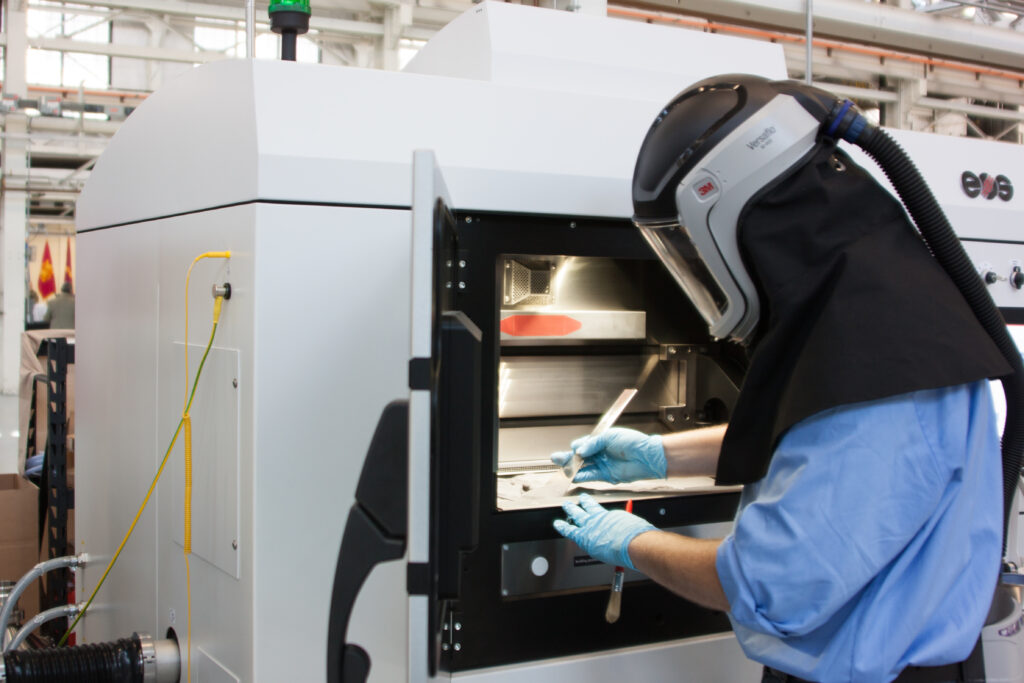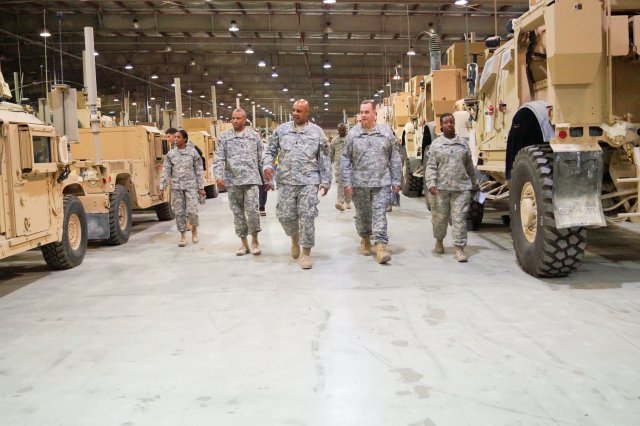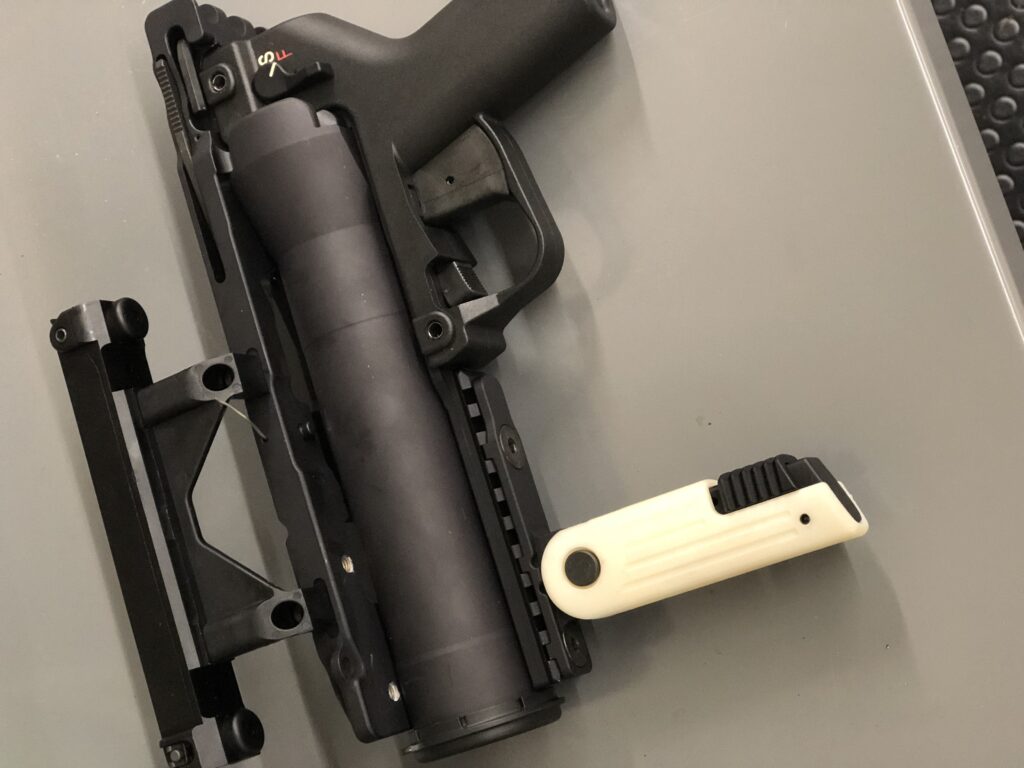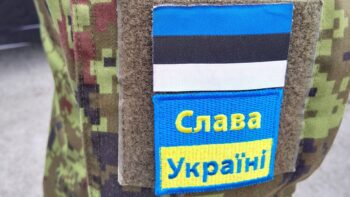
A worker at Rock Island Arsenal works with a 3D printer.
AUSA: A $25 million investment in industrial-strength 3D printers at Rock Island Arsenal, Illinois is the first step for revolutionizing Army readiness, the four-star chief of Army Materiel Command said in an interview.
[Click here for our discussion with Gen. Perna on AMC’s changing role in Army readiness]

Gen. Gus Perna
What the Army calls the Center of Excellence for Advanced & Additive Manufacturing only reached its Initial Operational Capability at an official ribbon-cutting in May. Full capability – which will include a design database accessible to forward-deployed units around the world – is not expected until March 2021.
But the Rock Island 3D printing facility is “already producing things and delivering them out to our depots, arsenals, and plants in the field,” Gen. Gus Perna told me at last week’s Association of the US Army conference. “Now I want much more volume.
“If you go out there, you’ll see about a quarter of my warehouse built,” he said. “My vision is we’re going to fill that whole warehouse with equipment to manufacture and get things out. My vision is Rock Island’s producing parts. Depots, arsenals, and plants are producing parts. Tactical brigades are producing parts.”
The State of the Art
Already, each of the Army’s 10 regular active-duty divisions – the level just above brigades – has its own 3D printer as part of its Metal Working & Machining Shop Set (MWMSS), which fit in shipping containers for deployment to war zones. Troops can download designs to print from an interim digital repository called Raptor, developed in-house by Army Futures Command.
“Soldiers are using that now,” said Maj. Gen. Daniel Mitchell, chief of Tank-Automotive & Armaments Command, who’s Gen. Perna’s pointman for advanced manufacturing. But, he and other Army officials cautioned reporters at the AUSA conference, that initial capability is limited. In particular, only prints polymers, not metals or other more robust materials, so it’s only been used for simple but vital parts like plastic caps.
Even with the more powerful machines at Rock Island, which can print metal parts, there are some high-stress, safety-critical components – say, rotor blades for helicopters – that Army officials say probably should never be 3D printed. On the other hand, some components are actually more reliable and higher-performing when printed as a single piece instead of being made from multiple pieces welded together. That includes certain kinds of rocket motors, jet engines, and key components of GE’s new Improved Turbine Engine for Army helicopters (see the video above).
But what all four services and the Defense Logistics Agency see as the low-hanging fruit is 3D replacements for existing parts, starting with simple ones. A Defense Department Inspector General report released this week found that “at least 81 Military Service depots, maintenance facilities, and field locations have used AM [additive manufacturing] to produce thousands of AM parts and tools, such as cooling ducts, clips, and wrenches.” What’s now necessary, the IG recommended, is standardization, systematization, and the sharing of data.
A significant first step in that direction: less than three weeks ago, new Army Secretary Ryan McCarthy ordered the systematic embrace of advanced manufacturing across the service. Ryan issued 53 specific taskings for different organizations. The parts of the Army with the most on their new to-do list? Futures Command and Materiel Command.

Army officers inspect one small portion of the massive logistics base at Camp Arifjan in Kuwait.
From Iron Mountains to 3D Printers
Even with the current limitations, Maj. Gen. Mitchell said, 3D printing has already allowed troops to repair broken equipment, like CROWS remote-controlled weapons stations, without having to wait for parts to be shipped from distant warehouses or, worse, laboriously hand-crafted to order.
That is the knotty logistical problem the military is trying to solve. Traditionally, the Army buys spare parts in bulk and warehouses them for decades, often to dispose of unused items en masse when the weapons system they were bought comes to the end of their useful life. The result is iron mountains of supplies that take months to build up in a war zone and are easy targets for advanced adversaries with long-range precision missiles, like Russia, China, North Korea or Iran.
Even with the mountains on hand, soldiers often find a key part is unavailable. That’s particularly true for older weapons, where the original manufacturer may have long since gone out of business.
So the Army’s goal is to print key parts that would otherwise be hard to get – not to run the entire military logistics system from a 3D printer. “We do not want to take over the supply chain. [We] 100% do not want to take over the supply chain,” Perna told me. “We don’t want to produce parts and sell them all around the world. [But] when we identify things that break consistently, and or are difficult to obtain in the supply chain, we want to be able to produce it. We want to produce it forward, we want to produce it in the depots, arsenals, and plants.”
Perna expects most supplies will continue to come from the private sector, which is making its own investments in advanced manufacturing techniques. That includes not just 3D printing – formally known as additive manufacturing – but a host of other advanced manufacturing techniques: new composite materials that blend, for example, the heat resistance of silicone with the strength of metal; conformal manufacturing that folds metal sheets into complex shapes; ultra-detailed digital models that can simulate wear and tear on real components; the use of robotics and artificial intelligence to allow more precise, flexible, and efficient manufacturing than traditional assembly lines.
“What I’d like to do is partner with them and take advantage of this great capability,” Gen. Perna said.

Bruce Jette
The Intellectual Property Problem
Working with industry, however, requires addressing a fundamental and historically intractable problem: intellectual property rights. You can’t just take whatever blueprints you find and 3D print them. If you don’t own the IP to that part, printing it without paying for it is a form of theft, warned the Army’s civilian acquisition chief, Bruce Jette, an engineer who holds patents himself and has played a leading role in developing more nuanced Pentagon policies on intellectual property.
“IP is one of my favorite topics,” Jette told a panel at AUSA. It’s his No. 2 priority, right behind developing his workforce, he said. The Army unveiled a new IP policy this year, which requires contracts to be much clearer about which party retains which rights and even allows award decisions to take account of the value of any IP rights included – or not included – in competing proposals.
It’s too early to divulge details of how this is playing out, Jette told reporters at AUSA. But he would say the new policy has already been implemented in multiple contracts and affected the award decisions.
While the new policy and intellectual property issues in general go far beyond advanced manufacturing – in particular, they’re crucial for software procurements and updates as well – they are a major potential stumbling block to 3D printing. Jette, however, looks forward to a future in which contracts routinely include the rights to print, perhaps paid out automatically like royalty checks.
Instead of paying the contractor to make more parts and ship them around the planet, he asked at AUSA, “how about we just put the licensing fee into letting us produce it at the front end? So now I’ve got a Forward Support Battalion, they download the file, they push the button, KACHUNK, out comes the doohickey….and a check comes in the mail because some guy in Poland just printed out one of your doohickeys. You didn’t have to do anything.”
“The guidance has been given by Dr. Jette to his PMs [program managers],” Perna told me. “We will obtain the government rights so that we can have access to everything we need.”

A 3D printed piece is attacked to an Army weapon.
Think Big, Start Small
The Army has a lot of work to do before it can make 3D printing routine. So far, it’s gone through roughly 45,000 parts that potentially could be printed on demand, carefully evaluating which ones were actually feasible. Most don’t have detailed 3D digital designs, Mitchell said, “[but] do we at least have a 2D drawing?” Now the Army has culled that list to 1,650 items, for which they’re developing detailed technical data and testing procedures.
Even where 3D printing is proven practical, the Army still must determine whether that specific 3D printed part is sturdy enough to be a permanent replacement or should be a stopgap until a traditionally manufactured part can arrive. And fast-moving combat units can’t carry around the same industrial-grade equipment available to fixed sites like Rock Island, Perna noted.
“If you give them too much machinery, how are they going to move that around on the battle field?” Perna asked. “So what if you can make every single part? If they can’t move, they die.”
So the Army has to figure out what kinds of 3D printing capabilities are appropriate for different kinds of units and different echelons of command. And it has to do so in a context, not of Iraq or Afghanistan with well-established US bases and control of the air, but a future conflict against Russia or China. Units will be spread out and constantly on the move, with their supply lines under strain and under attack.
There is one upside, however. This future environment should bring new and more capable global networks to move the necessary data around the world.
“Dr. Jette has done the guidance on the government rights. He’s created the policy,” Perna said. “Now we are responsible for establishing the digital thread.” That means legal and technical information on parts that an Army soldier or depot worker can access from the field. The goal is a search interface as easy as Google or Amazon, he said, where the user types in what they need, and the system replies “‘Yep, you have data rights. Here are the 3D drawings. Just send it to whatever machine you tell us.’ And he pops into the machine and we’re good.”
It’ll take a while to get there, Perna freely acknowledged, but you won’t ever get there if you don’t let yourself imagine the possibility. “So,” he told me, “let’s think big, start small, and then let’s escalate expeditiously.”
Read Part II of our interview with Gen. Perna, on Army Materiel Command’s changing role:
Taking aim: Army leaders ponder mix of precision munitions vs conventional
Three four-star US Army generals this week weighed in with their opinions about finding the right balance between conventional and high-tech munitions – but the answers aren’t easy.



























